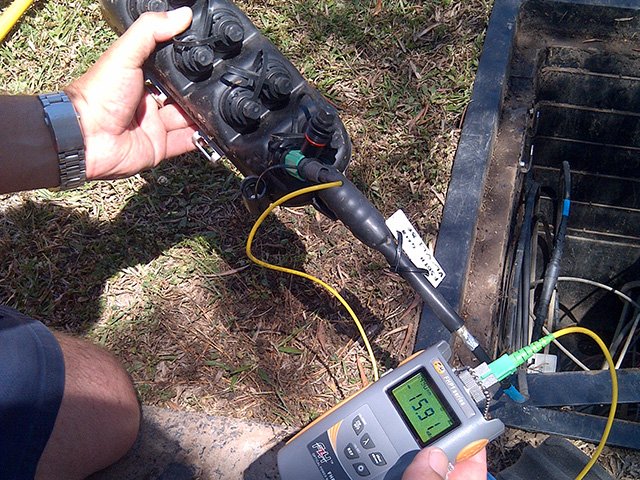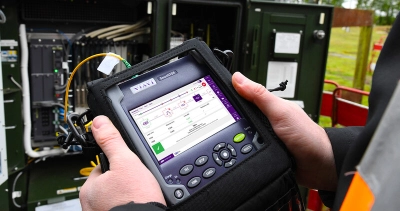Investing in optical fibre testing equipment improves network performance.
Revealing the Secret Use Optical Fibre Evaluating for Reliable Information Transmission
In the world of modern-day communication, optical fiber testing becomes an essential technique for maximizing information transmission. By employing methodologies such as Optical Time Domain Reflectometry (OTDR) and insertion loss analyses, network drivers can properly identify and attend to issues that might jeopardize signal honesty. As the need for faster and extra trusted connections remains to climb, the effects of these screening techniques extend beyond immediate fault discovery, influencing long-term network performance. Comprehending the diverse applications of optical fibre testing invites a deeper exploration right into its critical role in forming the future of data communication.

Value of Optical Fibre Screening
The importance of optical fiber screening can not be overemphasized, as it functions as an important element in making certain the dependability and efficiency of information transmission systems. In an age where high-speed communication is extremely important, any deficiencies in fibre optics can result in considerable information loss and decreased performance. Strenuous screening methods are essential to confirm the honesty and performance of optical cords.
Evaluating permits the recognition of flaws such as micro-bends, macrobends, and splice losses that could impede signal top quality. In addition, it offers understandings into the overall attenuation and bandwidth capabilities of the fiber, making sure that the network meets specific functional requirements. Routine screening not just boosts system performance but likewise prolongs the life-span of the facilities by determining possible issues before they rise into expensive failures.

Sorts Of Optical Fiber Tests
Different kinds of optical fibre tests are performed to make sure the performance and integrity of fibre optic networks. These tests can be classified right into a number of essential types, each serving a particular function in evaluating the stability of the fiber.
First, Optical Time Domain Name Reflectometry (OTDR) is a popular examination that recognizes mistakes, entwines, and connectors within the fibre. By sending out pulses of light and examining the mirrored signals, professionals can pinpoint issues along the fiber's size.
2nd, insertion loss tests review the amount of signal loss when light passes through ports or splices, which is critical for maintaining network performance.
Third, return loss tests determine the amount of light showed back in the direction of the source, providing understandings right into the high quality of connections and prospective resources of interference.
Furthermore, continuity tests ensure that the fibre path is total, allowing specialists to validate that the fiber is intact with no breaks. robotic vision.
Lastly, visual mistake locators utilize visible light to recognize breaks or serious bends in the fiber, assisting in fast troubleshooting. Collectively, these examinations form an extensive strategy to maintaining optimal performance in fibre optic networks.

Applications in Network Maintenance
In contemporary telecommunications, effective network maintenance counts greatly on optical fibre testing to identify and remedy concerns promptly. Normal testing guarantees that the network runs at ideal efficiency degrees, decreasing downtime and improving user experience.
One of the primary applications of optical fiber screening in upkeep is the discovery of faults, such as breaks, bends, or inappropriate connections. Techniques like Optical Time Domain Name Reflectometry (OTDR) enable professionals to situate these problems precisely and examine the high quality of the fiber link. Additionally, loss testing confirms the honesty of the optical course, making certain that signal attenuation stays within appropriate limits.
Regular maintenance screening likewise assists in safety nets, determining possible troubles prior to they intensify right into significant failings. This aggressive method can conserve organizations both time and funds. Additionally, throughout upgrades or expansions, optical image source fiber testing ensures that brand-new setups integrate effortlessly with existing infrastructure.
Enhancing Information Transmission Dependability
Reliable network maintenance through optical fiber testing not only addresses prompt concerns yet additionally plays a significant role in improving information transmission reliability. By identifying mistakes, determining signal loss, and assessing the general condition of fibre optic cables, testing makes certain that potential troubles are remedied prior to they escalate right discover here into considerable interruptions.
Regular optical fibre testing, such as time-domain reflectometry (TDR) and optical time-domain reflectometry (OTDR), allows specialists to identify the specific areas of breaks, flexes, or connector problems within the network. This positive technique not only reduces downtime but additionally enhances the performance of data transmission by guaranteeing that the paths for signals are clear and functioning effectively.
Furthermore, testing help in validating adherence to market standards and specifications, which is critical for keeping the stability of information circulation. By ensuring that each link fulfills needed thresholds for loss and top quality, companies can boost their self-confidence in the reliability of their data networks.
Eventually, purchasing extensive optical fiber screening not only boosts information transmission reliability however likewise supports the long-lasting functional effectiveness of communication facilities.
Future Fads in Fiber Screening
Arising technologies are poised to transform fiber testing, leading the way for enhanced efficiency and precision in data transmission diagnostics (fibre testing equipment). As the demand for faster web and greater data transfer remains to increase, the integration of sophisticated devices such as expert system (AI) and artificial intelligence (ML) is established to change conventional fibre testing methods. These technologies will certainly make it possible for anticipating upkeep and automated mistake detection, dramatically minimizing downtime and improving network reliability
Additionally, the fostering of Net of Things (IoT) gadgets will facilitate real-time tracking of fibre networks, enabling for immediate identification of performance concerns. This change in the direction of aggressive administration will lessen disruptions and enhance data flow.
Moreover, innovations see in optical time-domain reflectometry (OTDR) and brand-new screening criteria will enhance the precision of dimensions, making sure that information integrity is kept throughout the transmission process. The development of 5G modern technology also necessitates the development of much more innovative fiber testing strategies to sustain its high-speed needs.
Final Thought
In conclusion, optical fiber screening is important for maintaining reliable information transmission within communication networks. Routine screening not only ensures conformity with market criteria yet also helps with aggressive upkeep, eventually contributing to the lasting reliability and efficiency of fiber optic systems.